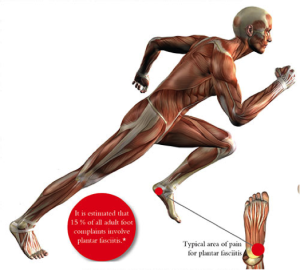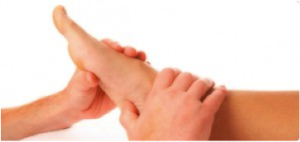Foot/Heel Pain and Physical Therapy
By: Anjanette Nunez, SPT and Chris Olson, PT, MSPT
Many patients come into the Sports Rehabilitation Center with complaints of intense foot or heel pain.
June marks the start of summer, and the iconic Peachtree Road Race is now just over a month away. In Atlanta, many runners are hitting the streets and trails, training hard in preparation for big races or just to keep in shape. Running, and other impact activities, places a lot of stress on the feet due to its repetitive nature and  increased ground reaction forces. These repetitive forces can cause degeneration and decreased blood supply to the plantar fascia, the soft tissue structure that helps support the arch of the foot. As the body attempts to withstand stresses on the heel (calcaneus), pain develops, and occasionally a bone spur will form along the inside on the heel. The pain is usually described as sharp, is worse in the morning, and arises after a long period of inactivity or at the end of the day.
increased ground reaction forces. These repetitive forces can cause degeneration and decreased blood supply to the plantar fascia, the soft tissue structure that helps support the arch of the foot. As the body attempts to withstand stresses on the heel (calcaneus), pain develops, and occasionally a bone spur will form along the inside on the heel. The pain is usually described as sharp, is worse in the morning, and arises after a long period of inactivity or at the end of the day.
What causes heel and foot pain?
Multiple factors can contribute to heel and foot pain. Although referred to as “plantar fasciitis,” inflammation may not be the sole cause of foot and heel pain. Also, the heel spur itself may not the cause of tenderness. Foot and heel pain is caused by overuse. Repetitive and prolonged stress on the plantar fascia (while running, for instance) can cause non-inflammatory degenerative changes in the soft tissue structures of the plantar fascia.[i] Overuse injuries to the foot may be associated with:
- Over-pronation
Think of this as the arch at the inside of your foot collapsing to the floor, causing your foot to flatten too much at the wrong time during your gait or running cycle. This can lead to inefficient foot function and increased plantar fascia stress.
- Tight heel cord
A tight heel cord can limit the amount of motion your ankle has to move into dorsiflexion (top of foot moving closer to the shin). This can further cause over-pronation as your foot begins to compensate for the lack of motion required as you walk or run.
- Weak stabilization muscles
If the muscles of the hip, knee and/or ankle are weak, they lose their ability to carry their share of load response as you walk or run. This causes greater force transmission into the foot structures, possibly leading to poor shock absorption and more stress on the plantar fascia.
- Other causes of foot and heel pain include a sudden increase in activities or training and a change of shoes – especially if they do not have a stable midsole to support your arch.
What can physical therapy do to help reduce foot and heel pain?
Physical therapy treatment for foot and heel pain should focus on several goals to allow for a gradual and effective return to activity. Physical therapy can help to:
- Decrease inflammation and pain with modalities and manual therapy
Current research has shown that skilled hands-on manual therapy and trigger point therapy including dry needling for the calf muscles effectively treat foot and heel pain.[i,ii]
- Address flexibility issues
Pain-free stretching of the heel cord and plantar fascia will help to increase the range of motion of ankle dorsiflexion and decrease the tension directly applied to the plantar fascia.
- Improve motor control
Therapeutic exercise and balance activities will help restore strength in intrinsic foot and hip, knee and ankle muscles, leading to improved ankle stability and reduced stress on the plantar fascia.

Return to activity
The ultimate goal of rehabilitation is to return to full activity. If you have foot and heel pain, the physical therapists at The Sports Rehabilitation Center can help you to modify activities, and can provide skilled rehabilitative therapy and treatment to safely and progressively allow you to return to your activities.
References
[i] Renan-Ordine R, Alburquerque-Sendin F, De Souza D, Cleland J, Ferandez-De-Las-Penas C. Effectiveness of Myofascial Trigger Point Manual Therapy Combined With a Self-Stretching Protocol for the Management of Plantar Heel Pain: A Randomized Controlled Trial. Journal Of Orthopaedic & Sports Physical Therapy [serial online]. February 2011
[ii] Ajimsha M, Binsu D, Chithra S. Effectiveness of myofascial release in the management of plantar heel pain: A randomized controlled trial. Foot (Edinburgh, Scotland) [serial online]. March 21, 2014; Available from: MEDLINE with Full Text, Ipswich, MA.